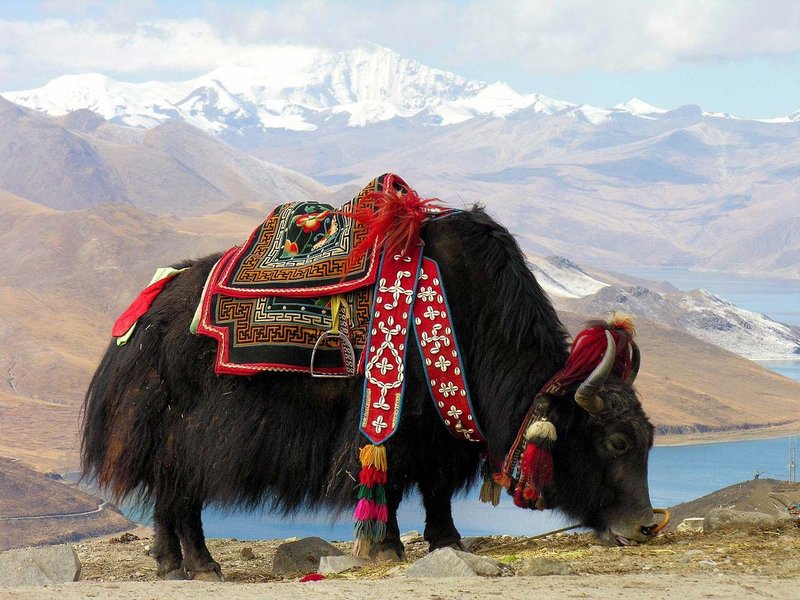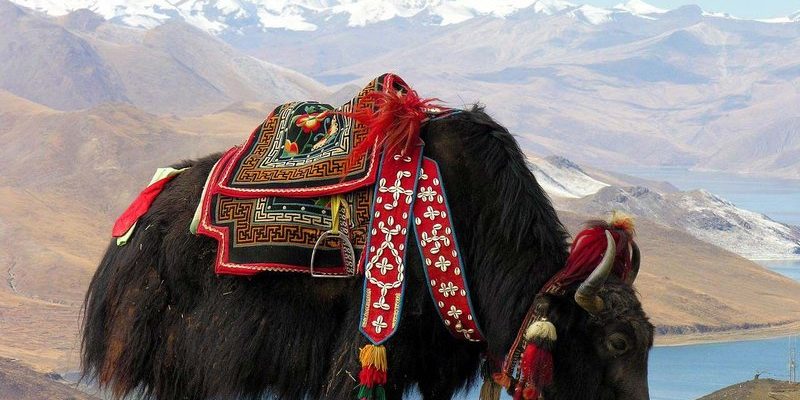
In this article, we’ll explore ten animals that are similar to the yak. We’ll look at their unique characteristics, habitats, and how you can tell them apart. You might be surprised at how diverse this group can be—like a family reunion, but with a mix of familiar and exotic faces. So grab a cup of coffee, and let’s dive into this wild family tree!
1. Bison
Bison may remind you of yaks with their robust physiques and shaggy fur. These massive herbivores are native to North America and can often be seen lumbering through grasslands. Like yaks, bison have strong body frames and a thick coat that helps them withstand tough weather conditions.
The key differences lie in their size and habitat. While both animals can be hefty, bison are generally larger, with males reaching up to 2,000 pounds. Yaks, on the other hand, typically weigh between 600 and 1,200 pounds. Bison are found in the plains and open forests of the U.S., while yaks prefer high-altitude regions.
How to Tell Them Apart
– **Habitat**: Bison live in the flatlands of North America, whereas yaks are mountain dwellers.
– **Size**: Bison are larger, with broader backs and thicker heads.
– **Horns**: Yaks have curved horns, while bison’s horns are more upward-pointing.
2. Water Buffalo
Water buffalo share a lot of traits with yaks, particularly their size, strength, and use in agriculture. These animals are often found in Asia and are well-adapted to wet and humid environments, which contrasts sharply with the dry, cold habitats of yaks.
Like yaks, water buffalo have thick, strong bodies, but their horns are a key differentiator. Water buffalo have large, sweeping horns that can curve outward, while yak horns are usually shorter and more condensed.
How to Tell Them Apart
– **Habitat**: Water buffalo are suited for wet, marshy areas, while yaks thrive in mountainous regions.
– **Color**: Yaks are often black or dark brown, while water buffalo can be gray or white.
– **Horn Shape**: Water buffalo have long, sweeping horns compared to the yak’s shorter, curved horns.
3. Musk Ox
Musk oxen are another fascinating cousin of the yak. These hardy animals are known for their thick wool, which provides insulation against the brutal Arctic cold. Just like yaks, musk oxen have a stocky build and are herbivorous grazers.
Musk oxen have very distinctive curved horns, which can be more prominent than those of yaks. Their thick fur and stout bodies help them survive in the harsh tundra, showcasing their resilience much like the yak’s adaptability to its high-altitude lifestyle.
How to Tell Them Apart
– **Habitat**: Musk oxen are native to Arctic regions, whereas yaks prefer high-altitude areas.
– **Fur Texture**: Musk oxen have thicker, longer hair known as qiviut, while yaks have dense, shaggy fur.
– **Horns**: Musk oxen have larger, more prominent horns than yaks.
4. Tibetan Antelope
Tibetan antelopes, or chiru, are another fascinating relation to the yak. While they are not as bulky, they roam the same high-altitude grasslands. Known for their striking appearance, these antelopes have long, slender legs and are incredibly fast and agile.
One of the main differences is their size and body shape. The Tibetan antelope is much lighter and more built for speed, while yaks are strong and sturdy. Both share the same habitat, but their lifestyles differ quite a bit.
How to Tell Them Apart
– **Size**: Tibetan antelopes are lighter and smaller than yaks.
– **Build**: Antelopes are sleek and built for speed, whereas yaks are muscular and stocky.
– **Coloration**: Antelopes have a tan-colored coat with white markings, contrasting with the yak’s dark fur.
5. Ibex
Ibex are wild goats known for their incredible climbing skills. These animals are found in the rocky, mountainous regions of Europe, Asia, and North Africa, making them distant relatives of the yak. While the ibex is much more nimble, they share a similar mountainous habitat.
A notable characteristic of ibex is their impressive horns, which can grow quite long and curve backward. This is different from the prominent body structure of yaks, which are designed for stamina and strength rather than agility.
How to Tell Them Apart
– **Body Shape**: Ibex are leaner and more agile than the sturdy yak.
– **Horn Size**: Ibex have longer, more spiraled horns compared to yaks’ shorter, curved horns.
– **Habitat Variation**: While both are mountain dwellers, ibex prefer sheer cliffs, whereas yaks are found on plateaus.
6. Domestic Cattle
Domestic cattle might seem like an obvious comparison to yaks. Both are used as livestock and share a lot of physical traits. However, there are some significant differences in their fur and size. Cattle can be found globally, from farms in the U.S. to pastoral communities in Asia.
While both animals are hardy, cattle come in many breeds, which can make them more varied in appearance. Yaks typically have a more uniform and thicker coat, ideal for harsh mountain climates.
How to Tell Them Apart
– **Fur Texture**: Yaks have a long, shaggy coat designed for cold climates, while domestic cattle have shorter hair.
– **Build**: Yaks are generally more muscular and compact compared to the more varied muscularity of cattle.
– **Horns**: Yaks’ horns are usually more curved than many domestic cattle breeds.
7. Sheep
You might be surprised to see sheep on this list, but they do have some similarities with yaks, especially in their grazing habits and flock behavior. Certain breeds, like the Tibetan sheep, are found in similar regions as yaks and share their grazing grounds.
However, sheep are typically smaller and have a fluffier coat. While yaks are built for strength and endurance, sheep are lighter and more delicate in their structure.
How to Tell Them Apart
– **Size**: Sheep are smaller and lighter than yaks.
– **Body Shape**: Yaks have a more robust and muscular body, while sheep are generally rounder and softer.
– **Horns**: Many sheep have a different horn structure, which can be spiral or curled, contrasting with the yak’s more distinctive horns.
8. Gaur (Indian Bison)
The gaur, also known as Indian bison, is a massive wild cattle species found in South Asia. These animals are closely related to both domestic cattle and bison, making them a relative of the yak as well. Gaurs are known for their impressive muscular build and can stand quite tall at the shoulder.
Though similar in size, gaurs have a more rounded back and longer legs compared to yaks. Their thick, dark fur can also vary in shade, making them look quite different in appearance.
How to Tell Them Apart
– **Build**: Gaurs have a more elongated body and longer legs than yaks.
– **Fur Color**: Gaurs can have varying shades, often with a reddish tint, whereas yaks are usually uniformly dark.
– **Territory**: Gaurs are mostly found in the dense forests of South Asia, unlike yaks that thrive in open mountains.
9. Arabian Oryx
The Arabian oryx is a striking antelope known for its beautiful white coat and long, straight horns. These animals were once on the brink of extinction but have made a comeback. While they’re quite different from yaks in many respects, they also share the arid habitats of high altitudes and deserts.
Oryxes are lean and fast, with adaptations for surviving in hot climates, unlike yaks that are built to endure cold. Their elegant appearance makes them stand out distinctly compared to the rugged yak.
How to Tell Them Apart
– **Size and Build**: Oryx are much lighter and more delicate than the stocky yak.
– **Horns**: Oryx have long, straight horns compared to yaks’ curved horns.
– **Color**: Oryx have a striking white coat with black markings, while yaks are mostly dark.
10. Red Deer
Red deer are gracefully built animals native to Europe and parts of Asia, known for their majestic antlers and elegant stance. While they don’t share the same habitat as yaks, red deer are also a part of the vast family of ungulates.
Red deer tend to be more slender and agile compared to yaks. Their similar grazing habits and herd behavior connect them as distant relatives in the animal kingdom.
How to Tell Them Apart
– **Body Shape**: Red deer are slimmer and more agile, whereas yaks are robust and powerful.
– **Antler Type**: Red deer have branched antlers that are shed annually, while yaks have permanent horns.
– **Habitat**: Red deer prefer forests and meadows rather than the mountainous terrains where yaks thrive.
In summary, yaks have a fascinating array of relatives, ranging from large bison to agile red deer. Each of these species shares certain traits with the yak, but they all have unique characteristics that set them apart. By understanding these differences, you can appreciate the rich diversity of the animal kingdom, even among those that might seem similar at first glance. It’s a reminder that nature often breeds a surprising variety of forms and adaptations, ensuring that each creature finds its niche in the world.

